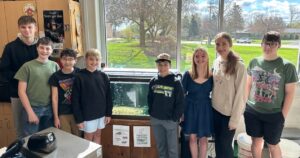Seventh-grade science students at Luxemburg-Casco Middle School this year are taking experiential learning to a high level through a new program, Trout in the Classroom. The educational initiative provides the students with hands-on exposure to the Salmonid life cycle which also directly relates to classroom instruction.
Trout in the Classroom was started at L-C by Middle School Science Teacher DJ Delebreau. He has worked closely with Logan Sikora, a senior fisheries biologist with the Wisconsin Department of Natural Resources (DNR) for Kewaunee and also Door counties.
The program provides students with the opportunity for immersive learning through the nurturing of Brown Trout from eggs to fingerlings. Students where able to observe the environmental conditions and also growth of the trout in the tank.
Sikora determined that Brown Trout would be the best option for L-C students to raise due to local fish communities and also environmental conditions.
“The students have really enjoyed having the fish in the classroom and watching them develop through their life cycle,” says Delebreau. “I have strived to relate and correlate our lessons in class to what’s going on in the tank of the fish.”
Trout in the Classroom
Trout in the Classroom is an environmental education program facilitated by Trout Unlimited. It is designed as a gateway stewardship experience for students. The organization says that “caring for the fish fosters a conservation ethic in the students, and the act of walking to a streambank and directly releasing the fingerlings into the water makes a concrete connection between caring for the fish and caring for the water.”
The learning process involves five primary steps: aquarium setup, receipt of the eggs, witnessing the Salmonid life cycle, maintenance of a healthy ecosystem, and connecting to the local watershed.
At L-C, the program got underway last November with the ordering of the eggs. Prior to that, Sikora inspected the tank and helped to obtain the special permits needed to raise the fish in the Middle School.
According to Delebreau, the students began with 100 eggs, raising them as fertilized eggs. Roughly 10 didn’t hatch and others hatched, but died right away. Approximately 75 viable eggs remained.
Students could measure out the amount of food that the fish receive on a daily basis and vacuum the tank out as they changed the water.
A smaller group of students actively monitor the fish and their environmental conditions. These include nitrites and nitrates, along with ammonia and pH levels, plus the stones on the bottom of the tank.
Learning Lessons
One learning lesson for the students was the need for organisms to have the correct environmental conditions to survive. For the fish, the water initially was changed once per week when they were in the fry stage. As the fish grew larger into the fingerling stage, they produced more waste. This resulted in the loss of some fish due to higher nitrite levels. Now the water is changed on a daily basis, which corrected the problem.
As of late April, 55 fish remained. Delebreau says that viability above half (50) is considered good.
The developed Brown Trout will be released into nearby Scarboro Creek on a May date to be determined by Sikora.
Total Dairy Service of Kewaunee, led by co-owners Jamie Jeanquart and Dan Hanrahan, played an integral role in the start of the program at L-C. The company provided funding for the Trout in the Classroom kit, including the eggs, and also donated the fish tank.
Delebreau hopes to continue the program in future years.
“I am planning to do it every year,” he says. “I have enjoyed observing the knowledge and understanding that students have gained from this experience. They have witnessed the connection between classroom learning and the importance of environmental conservation. It also has highlighted the role of students in preserving aquatic ecosystems.”
Trout in the Classroom has proven to be a success for both L-C students and the Kewaunee County ecosystem.



